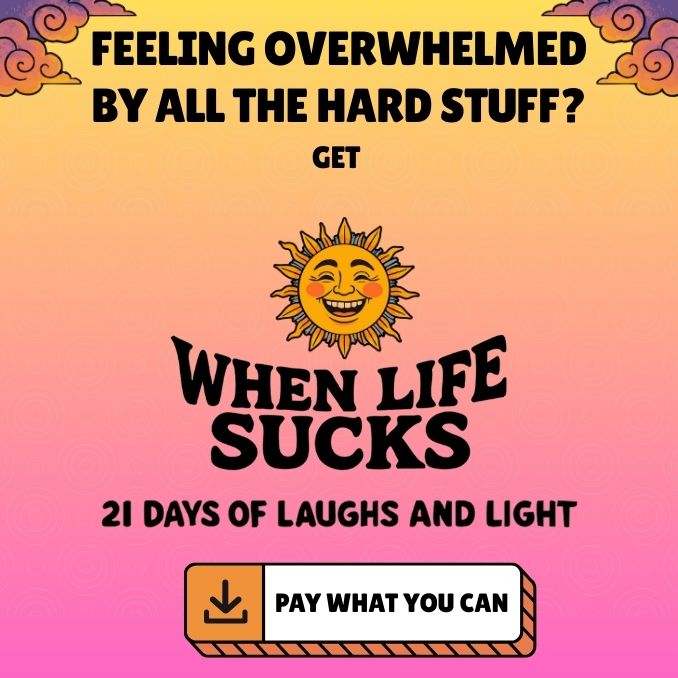
“Letting go gives us freedom, and freedom is the only condition for happiness. If, in our hearts, we still cling to anything—anger, anxiety, or possessions—we cannot be free.” ~Thich Nhat Hanh
Back in 2001, I was a freshman in college, and my saving grace from anxiety was a yoga class. More specifically, it was the most glorious of poses we call savasana that kept me sane.
For those unfamiliar, savasana—or corpse pose—is a pose of surrender and noticing thoughts and sensations without judgment, much like meditation. (It’s the pose that looks like everyone is just lying around napping.)
Back then, yoga and meditation were still mostly seen as these hippie things that flaky people do. There were certainly no yoga classes anywhere near my hometown in Connecticut, so I hadn’t had the chance to even try yoga before college. And as far as I knew, meditation was something that monks did on a mountain side.
Without the three physical education credits my college required, it likely would have been years before I experienced the peace that is savasana.
College was a very stressful time for me, as it is for most people. I still had no idea at this point that what I had been experiencing most of my life was anxiety. All I knew was that there was a bee’s nest living inside my chest, vibrating at an angry frequency that made my skin crawl.
I rarely went to parties or out to bars (even though I had my handy fake ID, which was surprisingly easy to get back then). The fear of what the “much cooler” kids would think of me kept me in my dorm room watching Empire Records, Tommy Boy, and The Emperor’s New Groove on VHS over and over and over again (we didn’t have cable and YouTube wasn’t a thing yet).
The worry of making my parents proud exhausted me. The fearful anticipation of being called on in class and not knowing the answer haunted me. The pressure to be at the top of every class crushed me under the weight of receiving a B.
I didn’t know how to escape these feelings. I wasn’t given the tools. I wasn’t told what it was. I was raised in a “suck it up” kind of household and thought I just needed to “deal with it.”
To distract myself from the internal pain, I started inflicting some externally. I’d gnaw at my skin with a dullish blade or dig my nails into my arms—not to break the skin, but to have a more tangible pain to focus on. One that I could control, one that I could look at and point to and know where it came from.
I knew it wasn’t constructive or healthy, but I didn’t seem to have the words to talk about how I felt. I just knew that was the best idea I had at the time.
That “solution” thankfully didn’t last for long. Soon I was introduced to the saving grace that was the last eight minutes of yoga class.
The class was held on the hard, barely carpeted, cold concrete floor of my dorm building’s basement. It was right in the middle of the day, and the beautiful final pose of the class always made me feel fantastic. It became the reason I went and still is my favorite part.
The peace would last anywhere from five to ten minutes. I was told to listen to the space between my breaths. I started to notice that there was this place I could go that didn’t have noise that would last for mere seconds, though it felt much longer.
It was so tranquil. It sometimes felt like a rush of calming chemicals were being released in my brain. It was, for lack of a better term, amazeballs.
Amazeballs
a·maze·balls (əˈmāzbôlz)
Adjective, informal
Extremely good or impressive; amazing.
In those moments there was no bee’s nest, no crawling skin, no need to escape. For a few minutes a day for three days a week, I felt peace.
After a while I noticed that I was carrying that stillness with me through the rest of my day. It fueled me.
But sometimes I thought I was doing it wrong because I couldn’t “shut my brain up.” I didn’t realize that I was essentially meditating. I didn’t truly know what I was learning through the process. I had no idea just how impactful it was. I only knew I felt great afterward.
That is why I’m writing this post. Through years of meditation practice since those glorious days on the cold basement floor, I’ve learned how and why meditation was helping me and my anxiety, my confidence, and my overall mental health.
These are the things I wish I knew meditation was doing for me earlier in life. Had I known these back then, I would have sought out a proper teacher much sooner and made it a daily practice instead of weekly, and learned to practice mindfulness off the cushion as well.
1. Meditation teaches us the difference between ourselves and our thoughts.
When we meditate, we learn to notice when a thought is happening, as well as when it has taken our attention and we’ve become absorbed in it. Once we recognize this, we bring our attention back to a point of focus.
In learning meditation you will be introduced to the concept that you are not your thoughts. That they are not one in the same.
This idea blew my mind when I was first heard it. “If I’m not my thoughts, then what am I??”
Some call it our Wise Advocate. Others call it our Inner Self, or our Soul. I just call it Me.
Think of your brain like another sensing organ. The eyes see, the ears hear, the brain thinks. You are not your thoughts as much as you are not the things you see.
Our brains serve up ideas, not truths. A thought is merely a sentence constructed by the neurons in our brains. It’s up to us to decide if we believe the thought, or if we want to choose another one that feels more true to ourselves and our values.
When we differentiate between the two—there’s me and there’s my thoughts—it gives us the power to choose. We are not subjected to or victims of the ideas we hear our brains serve up.
When thoughts like “I suck” or “I can’t handle this” or “No one will like me” come to mind, these are not truths, these are ideas our brains came up with.
It’s up to us to recognize that is a thought, not us. We can choose to believe it or choose to question it, reframe it, and find a thought that serves us better.
Meditation is a practice that builds this skillset of noticing thought, recognizing it for what it is, and stepping back far enough from it to choose where to go next.
2. Meditation teaches us how to let go of thoughts, and improves sleep.
“My brain won’t shut up!!!” I told my doctor when I asked him for something to help me sleep.
Meditation is like a workout for your brain. Except instead of picking up weights to build muscle, you’re putting down thoughts to build strength of mind.
When we meditate, we notice when thoughts arise, then gently bring our awareness back. That awareness could be on the movement of your breath, the feel of your body, the sound of a mantra, or the visual of a mandala—an anchor to bring you back to the present moment.
Then your mind will wander again. Then you bring it back. Then it wanders. Then you bring it back.
It’s like doing reps at the gym. You’re building the “muscles” that bring your mind back to the present moment, giving you more control over the direction of your attention.
And over time your ability to let go of thoughts—especially those that do not serve you—grows. This makes it easier to fall asleep, to get out of a funk, and to clear your mind and find more peaceful moments in life.
Thoughts, worry, rumination, fear—these keep us up at night. These thought patterns became so habitual for me that it even felt impossible to let go daydreaming while I was trying to fall asleep.
By learning to disengage from the thoughts spinning on the hamster wheel, we’re able to drift off to sleep.
3. Meditation teaches us self-compassion and patience.
Meditation is a pretty simple concept, but it isn’t always easy, especially when we are just starting out.
Thoughts come and go all the time. That’s what our brains do—it’s one of it’s jobs, to give us thoughts. When we meditate we’re continually recognizing that we are thinking. “Ah, that’s a thought.”
Learning to not attach ourselves to that thought takes practice. And practice takes time.
Just like how you can’t force yourself to fall asleep, you can’t force yourself to ‘go deeper’ into meditation. You allow it to happen. It takes patience.
And a lot of our anxiety comes from a place of impatience for the feeling to be over, for something in the future to make us happy.
With practice, meditation teaches us acceptance.
There may be times where you feel like you were thinking the whole time you’re meditating and you may find that frustrating, like you’re doing something wrong.
Or you may have been meditating for some time and feel you “should” have progressed faster in your ability to not get attached to your thoughts so often.
But, through the practice, we learn that we need to be kind to ourselves and accept that this is how our brain works. That there isn’t anything wrong with us.
It takes self-compassion to accept the present moment for what it is, especially when the present moment isn’t to our liking.
4. Meditation teaches us to be less judgmental.
We’re constantly judging ourselves and others. We put labels like “good” or “bad” on people based on their actions or appearance.
Judgment separates us from others. It’s isolating.
And when we judge ourselves we do the same. We’re separating ourselves from others. We might feel like we’re bad because we’re not as pretty, or smart, or talented. This judgment puts us in another category, separate from others, which is a lonely place to be.
Non-judgment is an important part of meditation, especially in mindfulness meditation.
Mindfulness is paying attention, on purpose, to the present moment, without judgment. That means experiencing without labeling in judgement.
Nothing is good or bad in this moment, it just is. A thought in and of itself isn’t good or bad. It’s just words or pictures. Just a fleeting idea. It is meaningless unless we choose to apply meaning to it.
When we meditate we witness our thoughts. We observe our feelings. We experience our bodily sensations. But we don’t judge them.
We approach them with curiosity. “Isn’t that interesting, I felt self-conscious when I noticed my stomach roll while sitting here.” Then back to the breath.
5. Meditation teaches us to not run away from our feelings and become confident.
During meditation, we’ll notice emotions coming up. Some are pleasant, some are not. But since we’re learning to not judge these things that come up, we’re also learning to allow them to happen.
When we experience emotions that are unpleasant—fear, anger, sadness, irritation—we naturally want to avoid them, hide from them, or dull them with food, alcohol, drugs or TV.
We gravitate toward comfort because comfort in our minds equates to security.
But emotions aren’t things that can physically harm us. They can cause muscle tension, queasiness, heat, a sense of heaviness… but there is no physical harm involved in a single instance of an emotion.
When we feel this afflictive emotion, we think “I don’t want to feel this, I shouldn’t feel this, it is bad to feel this.” And this resistance causes us more pain.
It’s like getting hit with a second arrow. The first arrow caused the negative emotion. This happens and it is part of our lives—we are meant to experience a range of emotions, both pleasant and unpleasant.
The second arrow, however, is avoidable. Pain is inevitable, but suffering is optional. When we apply resistance to that negative feeling, instead of leaning in and allowing it to be and to flow through us, we cause ourselves more pain.
We need to allow these feelings, to let them flow through and watch them pass. We witness how a thought or a feeling can’t harm us. It’s just passing by.
This is such an empowering skill because it makes us feel like we can handle anything. It builds confidence, because confidence is simply the willingness to experience a negative emotion.
6. Meditation can help you break habits and literally rewires your brain with new patterns.
Did you know that your thoughts can shape your brain? Like, literally. What you think and what you experience shapes the connections in your brain.
Thoughts and behaviors form neurological connections. If we do something often enough, or if our actions result in a desired outcome then the brain says, “Hey, let’s store this as a habit.” Like saving a computer program.
Worry, rumination, anxiety, stress, even daydreaming—these all can become habits.
The brain likes habits. It helps it work more efficiently. If you’ve done something in the past and it worked even a little, it will store that in a secure part of the brain for safe keeping.
For example, rumination can be a habit. If in the past you worried about something and that felt like it was helpful to prepare for what is coming, the brain sees that as a successful pattern and voila! You have a habit of worry.
In the future, your brain will play this program when something stressful arises, because that is easier and more efficient than coming up with a new idea from scratch.
Just like it would be a lot of effort to have to re-learn how to drive every time you get into a car, you store those behaviors and automatically run that program once you sit in the driver’s seat.
Meditation rewires your brain through the process of neuroplasticity, which is the brain’s ability to form new connections (you can teach an old dog new tricks!). Habits start to break. And we start to gain more control over what we think, how we feel, and what we do.
I think this is the coolest part about meditation. It eventually allows us to respond to situations in the way we choose instead of always automatically reacting with our old, afflictive patterns. It allows us to fully become the person we know we are, the person we want to be.
About Sandy Woznicki
Sandy Woznicki is a stress coach helping parents find their inner calm and get to know, like, and trust themselves (so they can be the person, parent, and partner they are meant to be). Learn how to speak to yourself like someone you love with this free inner voice makeover workbook.













 Though I run this site, it is not mine. It's ours. It's not about me. It's about us. Your stories and your wisdom are just as meaningful as mine.
Though I run this site, it is not mine. It's ours. It's not about me. It's about us. Your stories and your wisdom are just as meaningful as mine. 